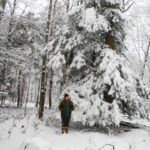My friend and fellow Druid John Beckett blogged about the importance of integration a few months ago. I wanted to add to his discussion and elaborate on some of the comments I posted to him. In a nutshell, his post looked at how compartmentalization (or separating one’s self into different pieces, not all of which is revealed all the time) is a normal practice in our culture. He argued that seeking integration is a worthwhile goal for druidry, where we can seek to integrate all aspects of ourselves into our druidic path. I’d like to pursue this idea of integration further and also bring in some learning theory that might give us tools to think about how to work to integrate ourselves in meaningful ways.
So what is this thing we call integration? What does it look like? How does it work? The concept of integration, at its base, is taking what appear to be disparate parts and unifying them into a cohesive whole. The term has a long, rich history: integration worked to end racial segregation, integration is also used as a concept in mathematics, psychology, life sciences, and electronics (and in the esoteric traditions, alchemy). So in Druidry, one way of seeing integration is by working to bring your spiritual philosophies in line with your everyday actions and interactions. For example, one way of thinking about integration would be looking at the concepts in the Druid’s Prayer (strength, understanding, knowledge, justice, the love of all existences, etc.) and working to integrate them into daily life in every way. This concept of integration is not easy to do by any means.
I want to talk about a set of theories from educational research and writing studies that might help us understand the principle of integration. In my career as a university professor, my primary research emphasis is as a learning researcher–specifically, I examine how people learn and use/adapt their knowledge to diverse circumstances (I study writing, but the concepts can be applied to just about any subject). This concept is called “transfer of learning” and it continues to be one of the most critical challenges we have in educating people–that they’ll actually use that knowledge in new places. This concept has a lot to do with integration and compartmentalization, but it will take me a while to explain it, so bear with me.
What we find in learning research is that often, when people learn something, they over-contextualize it (or as John might suggest, the compartmentalize it). I see this all the time in my research on college-level student writers–a student will learn how to write a particular genre really well, say, a business proposal. What the student doesn’t often realize, however, is that the broader skill of writing a proposal is embedded within learning the genre of a business proposal–there are lots of things about proposals, and about good writing in general, that can be learned from this single assignment. The problem, which I and other transfer researchers see time and time again, is that these broader lessons–about proposal writing, about writing in general, about processes and their own skills–aren’t emphasized and are lost to the student. In other words, the potential for learning and integration is great, but it is often not actualized (and the causes for why this is are numerous). From the perspective of writing, this is why often after 4+ years of higher education and potentially 100’s of written papers in a variety of genres, students go into their first job and seem like they’ve never learned to write anything at all. This same thing happens all over the place, where something is learned and compartmentalized, where integration fails to occur, and we are left with fragments rather than a whole.
What does successful integration from a learning perspective look like? The most successful learners are those that are able to assume a certain kind of mindset–a mindset of integration (transfer researchers have different terms for this, including “mindful abstraction” or “metacognition” or the “spirit of transfer”). The knowledge and experiences are are still there, still occurring, but what really changes is the learner’s relationship and mindset concerning that knowledge. So to go back to the business proposal example–the learner learns about the business proposal either way, but in the first circumstance (where you fail to transfer), the business proposal is compartmentalized and unless he encounters the exact same kind of situation in terms of writing, he’ll not use it again. The worst case scenario of this is when a learner fails to see their learning as useful to future circumstances at all and chooses to consciously forget it entirely (yes, this does happen more than one might think). But in an integrated view, the business proposal knowledge is seen in a broader perspective and is generalized as it is learned so that it can be applied in a variety of ways; additionally, the learner actively seeks to build connections to other kinds of writing and other areas where the knowledge is useful. Now when that person goes out into the world, that knowledge is at his fingertips rather than buried in a box in a dark corner of his mind (or forgotten entirely). In the end, successful learning is all about integration and mindset.
So how can one achieve the shifts in thinking required for successful learning and integration? Well, making a mindset shift is not an easy process. One of the primary things that comes out of the transfer research is the idea of extensive self-reflection–reflecting as you learn, reflecting on your own habits/processes, and working to actively build those connections. This reflection can be used to give one a set of tools to adapt knowledge, to integrate knowledge, and to interact with the world. This might be as simple as stepping back after an event and taking the time to journal or meditate about it, seeing what was done and how things could have been done differently. It might also be about reflecting during an event or process–taking a moment in the midst of what is happening to ensure you are going in the direction you’d like to go.
So in the end, we learn that integration is rooted in one’s mindset; its about seeing everything as connected to the whole, its about being about to integrate those experiences and beliefs and actions into a single, unified worldview rather than a set of disparate compartments. Its about active monitoring of our experiences, thinking about how the pieces fit, and deeply reflecting on those experiences.
To step back and apply learning research to druidry, we might look at the tree: trees must do a lot of integration in order to survive. In the tarot, we have the card of Temperance, which, in some decks (including my tarot deck) is a card about integration–its about bringing the elements into perfect balance and harmony. If you look at the image of temperance here, you can see that it is the tree itself that is able to bring the waters up from the depths, use the rich nutrients of the land, bring in the carbon dioxide from the air, and transmute the fire of the sun into an integrated whole. This is one way of seeing integration, as bringing together all parts into harmony and balance (and certainly, this is one of the main goals of the OBOD’s Bardic Grade).
Integration, ultimately, is a process, not an end product. Its a process of being, rather than a state of being. I can never achieve “integration” and then sit back and relax–it is an ongoing process that requires me to monitor everything I do and constantly seek ways of bringing my spiritual perspective into my daily life. To remind myself about the need and importance of integration, one of the mantras that I’ve developed is the following: “Everything I do, I do as a druid.” This means that every interaction and action, from choosing what I throw away to how I treat someone who has treated me poorly, I do as a druid. This mantra has helped me make this mindset shift and seek integration. Of course, there are times I fail in living up to the mantra, but even my failures can be used as experiences for learning and growth.




Thank you for this thoughtful post. It reminds me of some of the best advice I have ever received, “Study your successes.”
As a learning researcher, I’d say that another good piece of advice is to “study your failures” :). I think both have much to teach us!
This brings to mind the personality traits expressed in some Native American cultural concepts. Those with the ‘mouse’ personality compartmentalize everything in life, their sight is short, their activity is rapid and in the moment. Those with bird of prey personality have longer, larger vision, they take in the big picture, but often miss the details. Bringing these and the other possible personality traits into alignment to create a more holistic outlook could be a goal, or could be viewed as working against one’s own nature, but that begs the question. Do we work with where we are in our evolution, or do we seek to evolve further? What is the impetus for that evolution? How do you break through the mouse student’s tendencies and enlighten them to a wider perspective on their current work?
This is a great perspective. I like the idea of thinking about animal qualities and what they bring us in terms of perspective.
Another thing that is really powerful that we showed in the Permaculture group a few months ago was a short film called the “overview effect”. Its well worth watching:
http://www.planetarycollective.com/overview/
The difference perhaps in right and left brain thinking. Perhaps a harmony between the two?
Yes, that’s certainly one way of looking at it! 🙂